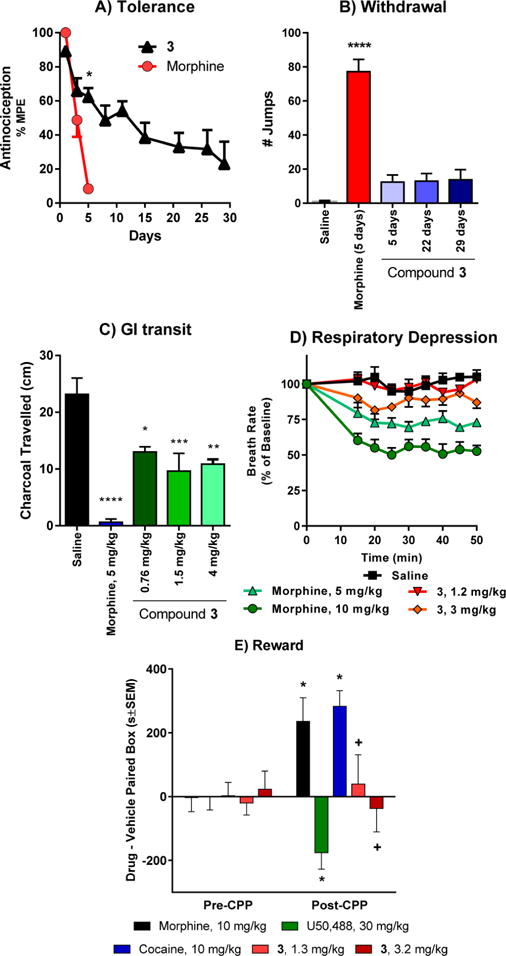Figure 6.

Side effect studies with compound 3. (A) Antinociceptive tolerance: Mice were dosed 2× daily with 2× antinociceptive ED50 with either morphine or 3 until they showed complete analgesic tolerance. 3 showed very slow onset of tolerance compared with morphine. *Significantly different from morphine (p < 0.05). The experiment was replicated at least twice with similar results. (B) Physical dependence: Groups of mice were dosed 2× daily with 2× antinociceptive ED50 with morphine or 3. Separate groups of mice were used for the 5, 22, and 29 day treatment with 3 and the animals within each group were sacrificed following the experiment with naloxone. Animals were challenged with naloxone (1 mg/kg) on day 5 of the morphine group, and days 5, 22, and 29 of the 3 groups. Number of jumps was counted over a 15 min period postinjection. The response of mice treated with 3 on either day was not significantly greater than that of mice treated with saline. *Significantly different from saline. (One-way ANOVA followed by Dunnett’s multiple comparison test, p < 0.05). (C) Gastrointestinal transit. Groups of mice (n = 10) received saline, morphine (5 mg/kg), or 3 (1.5 and 4 mg/kg) before receiving an oral dose of 0.2 mL of charcoal meal by gavage. Animals were sacrificed 30 min later, and the distance traveled by charcoal was measured. 3 lowered transit significantly compared with saline (P < 0.05) but less than morphine at both doses (P < 0.05) as determined by ANOVA followed by Tukey’s multiple-comparison test. The inhibition of gastrointestinal transit seems to plateau even at doses ∼5× higher than the antinociceptive ED50. (D) Respiratory rate. Animals were randomly assigned to receive saline (n = 5), 3 (1.2 and 3 mg/kg, sc, n = 5 at each dose) or morphine (5 and 10 mg/kg, n = 5 at each dose). While morphine caused respiratory depression at both 2× and 5× antinociceptive ED50 dose (5 and 10 mg/kg, respectively), 3 did not depress respiratory rate at ∼2× antinociceptive ED50 dose (1.2 mg/kg) and was not significantly different from saline at any time point, whereas morphine (5 mg/kg) decreased respiratory depression in comparison with 3 (p < 0.05) as determined by repeated-measures ANOVA followed by Tukey’s multiple-comparison test. However, at ∼5× antinociceptive ED50 dose (3 mg/kg), 3 showed signs of respiratory depression albeit significantly less than the equianalgesic dose of morphine (10 mg/kg) at any given time point (repeated measures ANOVA followed by Tukey’s multiple-comparison test). (E) Conditioned place preference and aversion. Compound 3 alone did not produce conditioned place preference or aversion. After determination of initial preconditioning preferences, mice were place conditioned daily for 2 days with morphine (10 mg/kg/d, ip), U50,488 (30 mg/kg/d, ip), cocaine (10 mg/kg/d, ip), or 3 (1.3 mg/kg/d, ip and 3.2 mg/kg/d, ip). Mean difference in time spent on the drug-paired side ± SEM is presented (n = 17–21). * Significantly different from matching preconditioning preference (p < 0.05); + significantly different from cocaine, morphine, and U50,488 preference (two-way repeated measures ANOVA with Sidak’s post hoc test).
